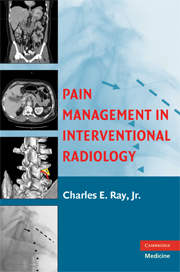Book contents
- Frontmatter
- Contents
- Contributors
- Preface
- Acknowledgments
- 1 Pain Management in Interventional Radiology: An Introduction
- 2 Clinical Evaluation of Low-Back Pain
- PART I LOCOREGIONAL PAIN CONTROL
- 3 Local Anesthetics
- 4 Functional Lumbar Spine Anatomy: A Review
- 5 Percutaneous Vertebroplasty
- 6 Kyphoplasty
- 7 Epidural Steroid Injections
- 8 Selective Nerve Root Blocks
- 9 Discography
- 10 Facet (Zygapophyseal) Joint Injections
- 11 Articular Interventions in Pain Management: A General Approach
- 12 Percutaneous Management of Visceral Pain
- 13 Embolization of Painful Neoplasms
- 14 Image-Guided Ablation of Painful Osteolyses
- 15 Chronic Pelvic Pain in Women
- PART II SYSTEMIC PAIN CONTROL
- Index
- References
5 - Percutaneous Vertebroplasty
from PART I - LOCOREGIONAL PAIN CONTROL
Published online by Cambridge University Press: 04 September 2009
- Frontmatter
- Contents
- Contributors
- Preface
- Acknowledgments
- 1 Pain Management in Interventional Radiology: An Introduction
- 2 Clinical Evaluation of Low-Back Pain
- PART I LOCOREGIONAL PAIN CONTROL
- 3 Local Anesthetics
- 4 Functional Lumbar Spine Anatomy: A Review
- 5 Percutaneous Vertebroplasty
- 6 Kyphoplasty
- 7 Epidural Steroid Injections
- 8 Selective Nerve Root Blocks
- 9 Discography
- 10 Facet (Zygapophyseal) Joint Injections
- 11 Articular Interventions in Pain Management: A General Approach
- 12 Percutaneous Management of Visceral Pain
- 13 Embolization of Painful Neoplasms
- 14 Image-Guided Ablation of Painful Osteolyses
- 15 Chronic Pelvic Pain in Women
- PART II SYSTEMIC PAIN CONTROL
- Index
- References
Summary
INTRODUCTION
The first percutaneous vertebroplasty (PVP) using imaging guidance was performed in France in 1984 (1). The injection of polymethylmethacrylate (PMMA) by Galibert et al. into a painful C2 hemangioma relieved the patient's pain (1). Since that time, the interest and technical efficacy have improved to the point where PVP is used to treat osteoporotic and malignant compression fractures as well as primary and metastatic neoplasms of the vertebral bodies at all levels.
Prior to the development of PVP, painful vertebral compression fractures (VCFs) were treated conservatively. Indeed, current recommendations for PVP include failure of conservative treatment as a procedural prerequisite. The initial treatment of patients with painful VCF is a combination of immobilization, external bracing, and analgesic drugs (2).
Many pharmacological therapies are aimed at preventing the bone demineralization that can lead to compression fracture. The commonly prescribed medications include bisphosphonates, alendronate, and risedronate, which bind to hydroxyapetite and inhibit resorption. These agents are usually well tolerated and available in once weekly preparations (3,4). Calcitonin, administered as a nasal spray, prevents osteoclast-mediated bone resorption and may have analgesic properties. Finally, teriparatide, a truncation product of human parathyroid hormone, stimulates bone formation and is available for subcutaneous injection. The use of these agents can decrease the incidence of VCFs by 60% in one year (5,6).
Surgical intervention is needed in a small percentage of patients with VCFs. This is usually secondary to a neurological deficit resulting from the fracture deformity.
- Type
- Chapter
- Information
- Pain Management in Interventional Radiology , pp. 43 - 57Publisher: Cambridge University PressPrint publication year: 2008



